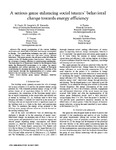A serious game enhancing social tenants' behavioral change towards energy efficiency
| dc.contributor.author | Casals, M | en |
| dc.contributor.author | Gangolells, M | en |
| dc.contributor.author | Macarulla, M | en |
| dc.contributor.author | Fuertes, A | en |
| dc.contributor.author | Vimont, V | en |
| dc.contributor.author | Pinho, LM | en |
| dc.date.accessioned | 2019-04-04T11:47:39Z | |
| dc.date.available | 2019-04-04T11:47:39Z | |
| dc.date.issued | 2017-08-23 | en |
| dc.identifier.isbn | 9781509058730 | en |
| dc.identifier.uri | http://hdl.handle.net/10026.1/13634 | |
| dc.description.abstract |
The energy consumption of the current building stock represents about 40% of the total final energy consumption in Europe. New gamification techniques may play a significant role in helping users adopt new and more energy efficient behaviours. This paper presents the advances achieved within the context of the EU-funded project EnerGAware - Energy Game for Awareness of energy efficiency in social housing communities. The main objective of the project, funded by the European Union under the Horizon2020 programme, is to reduce the energy consumption and carbon emissions in a sample of European social housing by changing the energy efficiency behaviour of the social tenants through the implementation of a serious game linked to the real energy use of the participants' homes. | en |
| dc.language.iso | en | en |
| dc.rights | Attribution-NonCommercial-NoDerivatives 4.0 International | en |
| dc.rights | Attribution-NonCommercial-NoDerivatives 4.0 International | en |
| dc.rights | Attribution-NonCommercial-NoDerivatives 4.0 International | en |
| dc.rights | Attribution-NonCommercial-NoDerivatives 4.0 International | en |
| dc.rights | Attribution-NonCommercial-NoDerivatives 4.0 International | en |
| dc.rights.uri | http://creativecommons.org/licenses/by-nc-nd/4.0/ | en |
| dc.rights.uri | http://creativecommons.org/licenses/by-nc-nd/4.0/ | en |
| dc.rights.uri | http://creativecommons.org/licenses/by-nc-nd/4.0/ | en |
| dc.rights.uri | http://creativecommons.org/licenses/by-nc-nd/4.0/ | en |
| dc.rights.uri | http://creativecommons.org/licenses/by-nc-nd/4.0/ | en |
| dc.title | A serious game enhancing social tenants' behavioral change towards energy efficiency | en |
| dc.type | Conference Contribution | |
| plymouth.publication-status | Published | en |
| plymouth.journal | GIoTS 2017 - Global Internet of Things Summit, Proceedings | en |
| dc.identifier.doi | 10.1109/GIOTS.2017.8016257 | en |
| plymouth.organisational-group | /Plymouth | |
| plymouth.organisational-group | /Plymouth/Faculty of Arts, Humanities and Business | |
| plymouth.organisational-group | /Plymouth/Faculty of Arts, Humanities and Business/School of Art, Design and Architecture | |
| plymouth.organisational-group | /Plymouth/REF 2021 Researchers by UoA | |
| plymouth.organisational-group | /Plymouth/REF 2021 Researchers by UoA/UoA13 Architecture, Built Environment and Planning | |
| plymouth.organisational-group | /Plymouth/Users by role | |
| plymouth.organisational-group | /Plymouth/Users by role/Academics | |
| dc.rights.embargoperiod | Not known | en |
| rioxxterms.versionofrecord | 10.1109/GIOTS.2017.8016257 | en |
| rioxxterms.licenseref.uri | http://creativecommons.org/licenses/by-nc-nd/4.0/ | en |
| rioxxterms.type | Conference Paper/Proceeding/Abstract | en |



